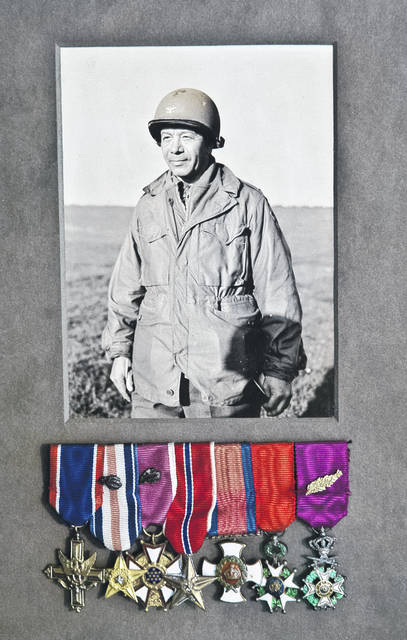
The cane once used by Teddy Roosevelt Jr. to direct the troops of the 4th Infantry Division during the D-Day invasion will be donated to the Musée du Débarquementon in France. But, before Delaware resident Beth Rieman delivers the cane to the museum on Wednesday, she wants to walk with it on the beach — letting it touch the sand one last time.
“I want to walk on the beach with the cane,” she said. “I plan on a full day to experience the beach and to walk in the footsteps of the troops. I want it to touch the sand one more time.”
Rieman said in order to get Roosevelt’s cane to France, the Musée du Débarquement paid for a plane ticket for her to make the trip to deliver it personally. She said it feels like the cane is coming full-circle by returning it to the beaches of Normandy.
The cane was discovered by Rieman while researching her great-granduncle James S. Rodwell, who was at the invasion and a close friend of Roosevelt.
“We were led to it,” she said. “We found it when we were going through all this stuff one summer and discovered that my uncle had a cane that belonged to Roosevelt.”
Rieman said the discovery of the cane began with a box of military medals that had been passed down to her mother belonging to Rodwell. She said Rodwell and his wife never had children of their own.
“He was very close to my grandma his whole life, but I don’t think she knew the significance of this because she would have told us,” she said.
Wanting to know more about the medals, Rieman began an internet search that only yielded information for Rodwell’s Distinguished Service Cross citation. She said she couldn’t find any other information on the other medals in the box.
Rieman said her mother had a scrapbook with the 4th Division’s insignia on it full of newspaper articles, pictures, military orders, citations, and letters.
“Every battle he had fought in was documented,” she said.
Among the artifacts, Rieman found a photograph of a letter written by Roosevelt addressed to Major General Raymond Barton, Commanding General of the 4th Infantry Division, urgently requesting that he lead the division’s assault on D-Day (June 6, 1944). But, there are indications in the letter that Barton had “informally refused” Roosevelt’s previous requests to lead the invasion forces.
“This letter, to me, says a lot about his personality and how the men felt about him,” Rieman said. “Part of his urging was, the men trust me, I will be able to keep their spirits up and things like that.”
Eventually, Roosevelt was granted permission to lead his troops in the invasion.
“He was the oldest man at D-Day, walking with a cane, and swinging it in the air, giving directions to his troops,” Rieman said about Roosevelt. “What a sight that must have been to see this man holding a pistol in one hand and waving a cane in the air with the other.”
Unfortunately, about a month after D-Day, Roosevelt passed away due to a heart attack.
“He must have been having a bunch of mini-heart attacks on D-Day,” Rieman said. “He must have told people, because he sent for his son to see him one last time. His son must have been on another beach or in a different wave in the invasion.”
According to Rieman, Roosevelt is buried at the Normandy American Cemetery and Memorial in France, not far from the museum where his cane will be on display.
After Roosevelt’s passing, Rieman said his cane was given to her uncle, who carried it through the rest of the war in honor of his friend and commanding officer. She said the 4th Division was the first to arrive on Utah Beach, and fought for a continuous 199 days in major battles — the Battle of the Bulge and the Battle of Hurtgen Forest — without returning to England to rest.
“After Roosevelt died, Uncle Jim took the cane with him,” she said. “They were so close, the cane was symbolic to him. The cane went everywhere in the European campaign.”
Rieman said she came across an article written in 1944 by the famous Pulitzer Prize-winning war correspondent Ernie Pyle, who planted himself within the troop regiments writing stories from the front lines of the war. She came across an article about her Uncle Jim written by Pyle.
“I started crying because it described (Uncle Jim) so completely and captured his personality,” she said. “It also included a single sentence that caught my attention: ‘He wears a new-type field jacket that fits him like a sack, and he carries a long stick that Teddy Roosevelt gave him.’”
With the article, Rieman said, there was a photograph Brig. Gen. Teddy Roosevelt, Jr. standing with his cane. She said inscribed on the back of the photo was: “Gen. Teddy Roosevelt, taken in front of Roddy’s command post — the day Gen. Roosevelt died.”
“My uncle was nicknamed “Roddy” for his last name, Rodwell,” she said.
Rieman said her father recognized the cane Roosevelt was standing with.
“My dad was like, ‘I think we have that cane, I almost burned it because it was all beat up. I almost just threw it in the fire like firewood,’” she said. “He brought it up, and we started to compare the modeling and looking at the different things on the cane in the picture.”
Rieman said her family talked about hanging onto the cane along with all the documents, photos, and newspaper clippings, but “it was clear he was proud of his service, and we felt like he wanted his legacy to be known.”
“I feel like I have a very strong connection with my uncle,” she said. “I feel like he was working behind the scenes to make this happen.”


